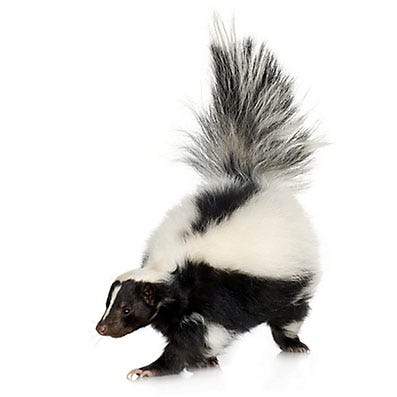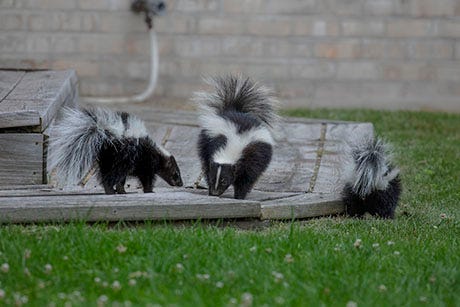
General Skunk Facts

North American Species:
- Striped skunk (Mephitis mephitis, most common)
- Eastern spotted skunk (Spilogale putorius)
- Hooded skunk (Mephitis macroura)
- Hog-nosed skunk (Conepatus leuconotus)
Average Size: 20-30 inches long (including the tail); 6-10 lb
Average Lifespan in the Wild: 2-4 years
Identifying Features: black and white fur; strong forefeet and long claws for digging
Fun Facts
- A skunk's sulfuric spray has a range of up to 10 feet, and its odor can be detected up to 1.5 miles.
- Skunks eat wasps and honeybees, and will often attack beehives.
- Immune to snake venom, skunks are known to eat venomous snakes like rattlesnakes.
- Although skunks have very poor eyesight, they have excellent senses of smell and hearing.
- A group of skunks is called a surfeit.
Identify Areas of Damage

In order to establish an effective skunk repelling plan, you must first become familiar with where your skunks live or frequent as well as their damage areas.
Common skunk habits include:
- living under your porch or shed
- eating your fruits or berries
- raiding your garbage cans
- burrowing underneath your lawn/home
- digging in your lawn for grubs and insects (leaving small, cone-shaped holes)
Choose the Best Skunk Repellent
Once you've identified your skunks' habits and whereabouts, use the information below to determine whether a liquid, granular, or electronic solution is best for you. A combination of repelling solutions will increase your chances of long-term success deterring skunks from your property.

Liquid Spray Repellents
Best For: Keeping skunks off of targeted surfaces. Spray liquid skunk repellents directly onto items such as:
- garbage cans
- corn stalks
- trash bags
- woodpiles
- plants
- mulch/grass
TIP: Skunks are poor climbers, so limit your application to reachable surfaces and plants - up to 3 feet from ground level.

Granular Skunk Repellents
Best For: Creating a skunk-repelling barrier around particular areas to keep skunks out. Sprinkle granules in or around the perimeter of areas such as:
TIP: Use granules to drive a skunk out of its burrow: generously apply granules at the opening of the burrow so that skunks will have to walk through the repellent when they exit and enter. The irritation caused by the repellents will make a skunk uncomfortable (particularly when it preens) and eventually drive him out.

Electronic Repellents
Best For: Detecting movement and frightening skunks with bursts of water. Electronics are great long-term solutions as they condition animals to stay away from an area. They are also chemical-free and safe. Use them in and around:
- vegetable gardens
- playgrounds
- property entryways
- pathways
- flowerbeds
- pool areas
- yards/lawns
- structures
- corn fields
- parks
- garbage cans
- woodpiles
TIP: Electronic repellents require very little maintenance, are eco-friendly and can be a great alternative to traditional liquid or granular repellents.
Apply as Directed

Carefully following application instructions is critical to the functionality of all animal repellents. Some very important steps to keep in mind include:
- To ensure lasting effectiveness, reapply liquid and granular repellents as often as indicated on each product's label. Although many repellents are weather-resistant, you should always reapply after heavy rainfall.
- Shake liquid repellents well before spraying, and for best results, use them in dry conditions with temperatures above 40°F. (For protection from skunks in temperatures below 40°F, consider a granular repellent).
- When setting up electronic repellents, make sure that the motion sensor and sprinkler are pointed in the direction skunks are likely to approach. Finding the right sensitivity may also take some trial and error - be patient.
Remove Attractants

Sources of food and shelter attract skunks to your property, so by removing these you will help improve the effectiveness of your repellents. Some extra steps to take to help keep skunks away from your property include:
- removing food/water sources
- removing trash
- controlling rodents
- closing gate/fence gaps
- fixing broken vents/screens
- cleaning up bird seed/pet food
Expert Tips
- When choosing a skunk repellent, select one that irritates skunks' heightened senses of smell and taste. Capsaicin, oil of black pepper or white peppers can serve as powerful scent and taste deterrents for these animals.
- Repellents will not separate a mother skunk from her young. If you find that after a few weeks of use, a skunk is continuing to return to her nest, it is possible that she has kits inside. Be patient and reapply persistently, and once the skunks are old enough to be on their own, they are more likely to relocate themselves.
- Skunks have an impeccable sense of smell, so it is very important to keep your yard clean of all traces of food and garbage to avoid attracting them. Safer® Brand suggests washing your trash bins periodically to keep them from attracting skunks.
- Skunks are sensitive to light. Reinforce your repelling plan by installing nightlights around your property - especially in common damage areas.

